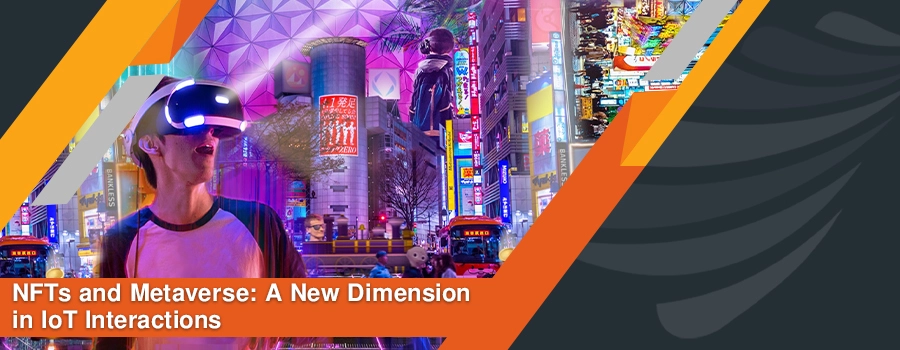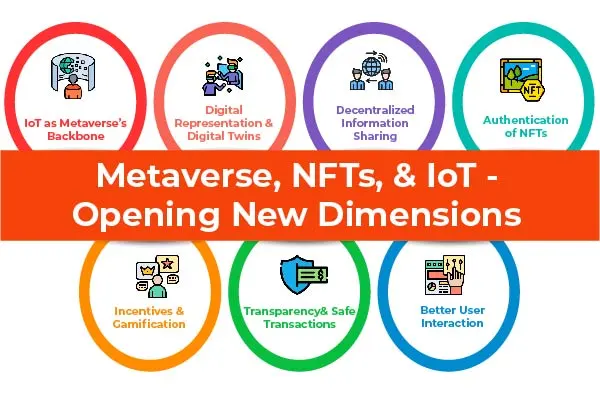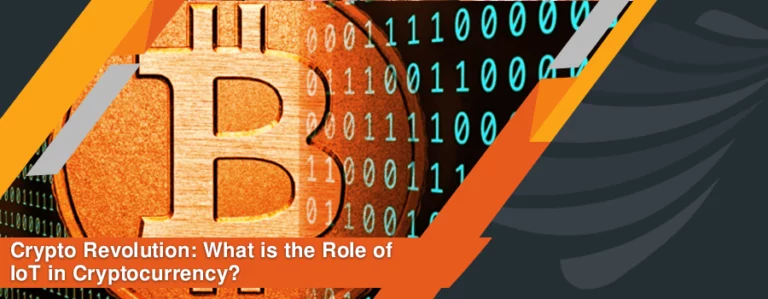In the compelling realm where the physical and real-world interlink, a new era of innovation unfolds – one that connects us to innovation and smart connectivity. A place where metaverse and Non-fungible Tokens (NFTs) coincide, opening opportunities for new possibilities that one could even imagine.
We welcome you to explore the thrilling journey of the coexistence of NFTs, metaverse, and Internet of Things (IoT) with us and delve into the new dimensions that cross the boundaries of reality and imagination.
What are NFTs?
NFTs are like digital ownership certificates for unique content or items in the digital world. To further understand, if you have a special edition trading card or a rare treasure in a video game, you can use it in the physical world by proving your ownership via a certificate or signature. In the digital sphere, NFTs function in the same way. With NFTs, you can prove your ownership, whether it is through music, digital art, virtual real estate, or even tweeting.
NFTs are digital assets tokenized via blockchain – a secure and transparent digital ledger. Blockchain technology ensures that the details of NFTs are secure, and the ownership details cannot be easily changed. On the other hand, tokens are distinct identification codes generated by an encryption mechanism from metadata. The assets are kept somewhere else, and these tokens are kept on a blockchain. What distinguishes them is the link between the token and the asset.
Depending on the market value and owner’s worth, you can easily trade and exchange NFTs for cryptocurrencies, money, or alternative NFTs. For example, you can capture a sunset view or draw a happy face over a cloud and then add information to tokenize it on the blockchain. The person holding the private keys to that token is the only one with access to its rights.
Some people might confuse NFTs with cryptocurrencies as both are tokens. The key difference is that cryptocurrencies are interchangeable from the same blockchain as they are fungible, but 2 NFTs can look identical. Still, they are interchangeable from different blockchain as they are non-fungible.
What is Metaverse?
Metaverse is a huge, single, shared, three-dimensional, virtually interconnected online universe that allows you to interact with others and experience a digital world in real-time. Instead of being a part of a single virtual world, you can experience interconnected digital spaces with internet access and enjoy anything you cannot or are willing to do in the physical world. You can become part of the metaverse by using your digital representations or avatars and engaging in activities like gaming, socializing, shopping, exploring, and working.
Eight elements currently form the metaverse: User interaction, blockchain technology, artificial intelligence (AI), computing vision, future mobile networks, edge and cloud computing, and the Internet of Things (IoT).
Metaverse is like a huge online house with different rooms, each providing a unique digital experience to users. As digital avatars, you can move from one room to another to experience different entertainment venues and workspaces. Metaverse grows as more advanced digital paces are formed and linked to form a vast, diverse 3d virtual space.
What is IoT?
The Internet of Things (IoT) is an interconnected network of devices or objects that can send and receive data via Internet connectivity. The network of IoT devices includes anything from wearable devices, appliances, industrial machinery, or automotive equipment. In other words, IoT allows different devices, wearables, equipment, and sensors to connect digitally and become part of smarter and more efficient innovations.
Relationship Between Metaverse and NFTS
The relation between NFTs and Metaverse is dynamic as they are transforming the future of the internet. Both enhance and influence one another in the digital realm to provide a unique experience to users. On the one hand, NFTs unlock unique opportunities in the vast interconnected space by providing ownership of unique digital assets. On the other hand, Metaverse serves as a digital space where NFTs come alive. For example, owning an NFT allows you to access exclusive virtual spaces and interactive experiences in the Metaverse. Metaverse serves as a stage where NFTs are traded and showcased.
The fusion of NFTs and Metaverse forms a groundbreaking space where virtual experience and digital ownership converge, redefining how we interact, perceive, and value digital content in the wider context of Metaverse.
Relationship Between Metaverse and IoT
The combination of the metaverse and IoT, also known as the Metaverse of Things, introduces a new level of interactivity and connectivity. It allows the integration of physical objects into the virtual world, enabling the integrated devices and objects to become functional in the virtual environment. Similarly, virtual objects can interact via IoT-enabled devices in the physical environment.
In the Metaverse of Things, gadgets and tangible items are outfitted with connectivity, actuators, and sensors, allowing them to produce real-time data and connectivity within the virtual environment. We can use this data to form digital renditions of physical objects and surroundings in the virtual realm, allowing users to engage with these digital representations. For example, you can manage smart home devices or monitor industrial machinery and operations via a virtual interface within the Metaverse.
Metaverse, NFTs, and IoT – Opening New Dimensions
The Metaverse, NFTs, and IoT come together in the complex network of the digital cosmos to create a story of interrelated possibilities and life-changing events. This symbiotic relationship opens the gate toward a digital landscape where trust, connectivity, and realism converge. Let’s look at the applications of this harmonious symphony where each element contributes to a futuristic digital landscape:
1. IoT as Metaverse’s Backbone
The Internet of Things (IoT) builds the infrastructure for secure transactions, immersive experiences, and smooth interactions in the infinite world of the Metaverse. It is the silent architect. The Internet of Things (IoT) emerges as the Metaverse’s central nervous system. The connectivity offered by the Internet of Things (IoT) provides the strength for the vast architecture needed to house the various technologies within the Metaverse. Customers can explore and fully immerse themselves in this virtual world because of this complex web of interrelated objects and beings.
2. Digital Representation and Digital Twins
Tokenized as NFTs, digital twins of the IoT are the virtual equivalents of actual items. After that, these digital twins settle in the Metaverse, where users can use immersive experiences to monitor and communicate with their physical devices.
3. Decentralized Information Sharing
NFTs provide IoT-generated data with the concepts of ownership and authenticity. Users can safely tokenize and trade these data assets in the Metaverse, promoting a decentralized and open data exchange system.
4. Authentication of NFTs
Integrating Metaverse realms and NFT using IoT devices creates a secure system. Guaranteeing the authenticity and ownership of digital assets represented by NFTs in the Metaverse creates the foundation for an open and reliable virtual economy.
5. Incentives and Gamification
The integration brings gamification aspects to the Internet of Things and Metaverse. An additional layer of motivation to interact with and improve their IoT experiences is provided by the ability for users to earn NFTs for accomplishments in optimizing or utilizing their IoT devices.
6. Transparency and Safe Transactions
The technology that powers NFTs is blockchain, which guarantees safe and transparent transactions. When blockchain is applied to IoT, it creates trust in data exchange, ensuring that information transfer between devices is tamper-proof and authentic.
7. Better User Interaction
Users can now visually immerse themselves in the virtual space, where NFTs are the digital keys to ownership and authenticity. These NFTs represent tangible and intangible assets, from virtual real estate and digital art to the data generated by IoT devices. As users navigate through the Metaverse, these tokens become the bridge that connects them to their IoT devices, seamlessly blending the physical and digital worlds.
Business Applications of Integrating Metaverse and NFTs into IoT
1. Personalized Advertisement
Personalized advertising is made possible by combining Metaverse, Internet of Things (IoT), and Non-Fungible Tokens (NFTs). By storing user information and preferences, NFTs can compile a thorough profile of virtual behavior. IoT monitors user behavior simultaneously in the real and virtual worlds. With the help of this connection, firms may precisely customize their adverts to appeal to certain consumer interests. As a result, the strategy is more precise and focused, increasing engagement, boosting revenue, and cultivating client loyalty.
2. Supply Chain Management
Integrating NFTs and IoT has revolutionized Supply chain management in several industries, including manufacturing, logistics, and agriculture. This partnership establishes a transparent and secure system for tracking and observing the flow of materials and goods. NFTs offer a virtual layer in the Metaverse to confirm these assets’ legitimacy. This guarantees the supply chain’s continued security, openness, and effectiveness. Organizations may use this connectivity to improve traceability, reduce risk, and streamline logistical procedures.
3. Virtual Commerce
NFTs, the Metaverse, and the Internet of Things together drive the advancement of virtual commerce into new security and efficiency frontiers. NFTs create a cutting-edge virtual marketplace by representing digital commodities like music and art within the Metaverse. IoT enables safe and automated transactions through smart contracts, guaranteeing a reliable and easy virtual commerce experience. This connection improves the general security of transactions within the Metaverse while streamlining digital asset purchasing and selling.
4. Healthcare Innovation
In the Metaverse, NFTs can safely represent medical records, protecting patient privacy. IoT devices can track and share health data in real time, enabling a tailored and dynamic virtual healthcare experience. This connection transforms healthcare delivery by enabling secure sharing of medical information, individualized treatment regimens, and remote patient monitoring.
5. Smart Work Meetings and Collaboration
Integrating NFTs, Metaverse, and IoT revolutionizes work meetings and collaborations. Virtual meetings can turn into 3D spaces with digital employee avatars facilitated by IoT devices. Employees can use their digital twins enabled by IoT to manage complex situations and multiple tasks remotely from anywhere. Such platforms make the meetings interactive and enhance employees’ capabilities to work remotely, but they also enjoy the experience and grow professionally.
6. Making Money on Digital Products and Services
Businesses can investigate new revenue streams by offering items and services that are exclusively available digitally by integrating them into the Metaverse. NFTs take on the role of these virtual assets’ digital ownership certificates. Limited edition NFTs representing digital goods, collectibles, or branded virtual goods can be sold by businesses. This allows companies to use the expanding Metaverse market for digital asset ownership.
7. Advanced Training and Education
The main issue with remote learning is that students frequently feel alienated because there isn’t a regular classroom environment. The ability to create virtual environments for projects related to education and training is presented by the integration of NFTs, Metaverse, and IoT. Students can engage in different virtual classrooms within the Metaverse by adopting digital avatars and staying connected with the help of IoT devices. Moreover, NFTs can be used as virtual currencies to pay fees, offering a smooth and creative way to conduct financial transactions in online learning.
How do you create your own Metaverse in just a few steps?
Creating your Metaverse requires a combination of innovation, imagination, and comprehension of different elements like virtual reality, blockchain, and networked systems. Here’s a quick guide to start your Metaverse:
1. Establish the Goals and Scope of Your Metaverse
Clearly state the intentions behind your Metaverse. Think about the experiences you wish to provide, such as gaming, socializing, teaching, or a mix.
2. Select the Correct Technology
Determine the technologies you’ll employ to construct your metaverse. This might incorporate IoT for linking physical items to the virtual world, blockchain and NFT integration for security, and virtual reality (VR) or augmented reality (AR) for immersive experiences.
3. Construct an Online Environment
To construct a virtual world or environment, use 3D modeling tools. Think about the buildings, scenery, and aesthetics that complement your idea of the Metaverse. Building the visual elements of your virtual environment can be greatly aided by platforms such as Unreal Engine or Unity.
4. Put Blockchain and NFTs into Practice
Use blockchain technology to give your Metaverse security, legitimacy, and transparency. Think about implementing smart contracts to make interactions and transactions easier in the virtual world. Use NFTs to permit ownership and represent distinct digital assets.
5. Create Internet of Things Connectivity
Increase interaction between the virtual and real worlds by integrating Internet of Things (IoT) devices. This could entail tying wearables, sensors, and real-world items to give users a more dynamic and immersive experience.
6. Create User Profiles and Engagements
Provide a mechanism allowing users to utilize avatars to represent themselves in the Metaverse. Consider avatar customization options and interactions to encourage social interaction inside the virtual environment.
7. Corporate Interactive and Social Features
To improve user interactions, incorporate social elements like voice communication, chat, and collaborative tools. To enable real-time user interaction, consider the inclusion of multiplayer features.
8. Guarantee Cross-Platform Interoperability
Ensure your Metaverse is compatible with multiple platforms to access various devices. These include mobile devices, desktop computers, VR headsets, and AR glasses.
9. Evaluate and Rework
To find and fix any bugs, concerns about security, or problems with the user experience, thoroughly test the system. Get user feedback regularly and change your Metaverse based on their suggestions.
10. Introduce and Advertise
Launch your Metaverse if you’re satisfied with the development and testing stages. Create a marketing plan to advertise your platform, draw users, and encourage community involvement.
Now, it’s time to redefine how you previously engaged with technology. Create your own Metaverse and become part of a future with connected groundbreaking, decentralized opportunities. The Metaverse is calling, and the future is yours to shape!
Practical Challenges
The integration of NFTs, the Metaverse, and IoT poses several problems despite their enormous potential. As various technologies converge, interoperability problems can surface, necessitating standardized protocols to guarantee smooth communication. Strong privacy protection measures are necessary due to security concerns, particularly when handling personal and transactional data within the Metaverse.
A further obstacle is the requirement for these technologies to be widely adopted and understood, necessitating educational programs to close the knowledge gap. Overcoming these obstacles is essential to fully realize this convergence’s revolutionary potential and create a secure, inclusive, and sustainable digital future.
Closing Thoughts
The nexus of NFTs, the Metaverse, and IoT offers exciting opportunities for innovation that has the power to completely transform the digital world. Such integration has provided opportunities to improve digital ownership, engaging experiences, and safe transactions. But general acceptance, security, and interoperability need to be handled together.
The promise of a smoothly connected future in which the virtual and real worlds coexist invites us to overcome these obstacles and work together to create a vibrant and inclusive digital age. The path ahead calls for investigation, cooperation, and a dedication to creating a future where the lines separating the actual world from the virtual world vanish.






